Tiny Ambassadors With a
Mission
by
Bob Brooke
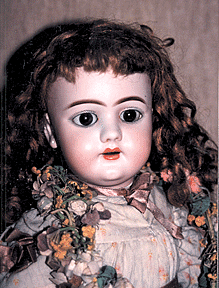 Lorna
Leiberman compares her doll collection to a box of chocolates, with so
many varieties and so many to chose from. Actually, the dolls don’t
really belong to her, but as the curator of the 5,000-doll collection at
the Wenham Museum, in Wenham, Mass., north of Boston, she’s their
caretaker. Lorna
Leiberman compares her doll collection to a box of chocolates, with so
many varieties and so many to chose from. Actually, the dolls don’t
really belong to her, but as the curator of the 5,000-doll collection at
the Wenham Museum, in Wenham, Mass., north of Boston, she’s their
caretaker.
This doll collection is unique and so is the
museum that it’s housed in, for the Wenham Museum bills itself as a
social history museum. What makes it different from other local museums
is that its exhibits concentrate on objects possessed by those who
lived, worked and played along Boston's North Shore since the 17th
Century. Through exhibits focusing on local life, including ice tools
used in the mid-19th-century Wenham ice industry, it explores the lives
of everyday people. And its vast doll collection shows how children,
especially little girls, played.
Elizabeth
Horton and Her Collection
Permanently displayed in the Osgood Gallery of the Museum is the
International Doll Collection (IDC), the original nucleus of the
Museum's doll collection. Donated in 1922 by Elizabeth Richards Horton,
a former resident of the Claflin-Richards House, which is now part of
the museum, the IDC is the oldest continuously held doll collection in
the world, containing a variety of exceptional examples. The collection
is one of few in the world to remain intact for over 100 years,
containing all original clothing and documentation.
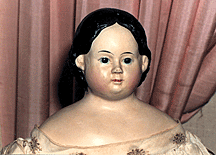 Horton was the daughter of the Richards family
who owned and occupied the Claflin-Richards House from the early 1800s
until 1921, when it was purchased by the Wenham Village Improvement
Society. Her home in Boston was a popular meeting place for neighborhood
children, and she kept a group of her childhood toys and dolls available
to entertain them. One day the children asked for the loan of these
dolls to display at a fair being held for the School for Crippled
Children. With an admission fee of five cents, the doll exhibit added $5
to the fair proceeds. There and then an idea was born. From then on,
Horton used her collection of over 800 dolls to raise money for
children's charities. Horton was the daughter of the Richards family
who owned and occupied the Claflin-Richards House from the early 1800s
until 1921, when it was purchased by the Wenham Village Improvement
Society. Her home in Boston was a popular meeting place for neighborhood
children, and she kept a group of her childhood toys and dolls available
to entertain them. One day the children asked for the loan of these
dolls to display at a fair being held for the School for Crippled
Children. With an admission fee of five cents, the doll exhibit added $5
to the fair proceeds. There and then an idea was born. From then on,
Horton used her collection of over 800 dolls to raise money for
children's charities.
The Museum's doll collection reflects the
aesthetics of dolls–the costumes and cultures of native and foreign
peoples and the history of the international doll industry. The dolls
offer insights into the values, manners and mores of past generations
and amaze visitors with the exceedingly high quality of their
manufacture and attention to detail and craftsmanship. The doll
collection has expanded to include over 5,000 dolls, ranging from
Egyptian burial figures from 1500 BC to 19th-Century porcelain play
dolls, even "Whimsies." It also includes period dolls of from
France, Germany, and England, as well as an important group of American
cloth dolls and rare 19th century Native American and Inuit dolls.
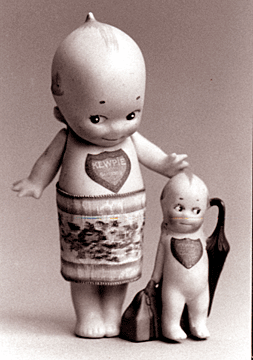 What’s unique about this collection is the
way Horton added to it. Being a school teacher, she had made many
contacts around the world through her travels and correspondence. Horton
would plan an itinerary a year in advance, pack her dolls and ship them
off to be exhibited as a charitable fundraising event. Over the years,
in an effort to expand her collection and give it some notoriety, Horton
wrote to officials, celebrities and the crown heads of Europe to request
donations to her collection. Many personalities of note responded,
sending dolls dressed in the appropriate costumes of their respective
cultures. The collection contains dolls from Queen Victoria, the Emperor
and Empress of Japan, Czar Nicholas and Czarina Alexandra, Admiral Byrd
and Cecil Rhodes, among others. It’s estimated that this energetic,
imaginative and talented woman raised approximately $100,000, and press
clippings from the period indicate the public's clear admiration and
appreciation. What’s unique about this collection is the
way Horton added to it. Being a school teacher, she had made many
contacts around the world through her travels and correspondence. Horton
would plan an itinerary a year in advance, pack her dolls and ship them
off to be exhibited as a charitable fundraising event. Over the years,
in an effort to expand her collection and give it some notoriety, Horton
wrote to officials, celebrities and the crown heads of Europe to request
donations to her collection. Many personalities of note responded,
sending dolls dressed in the appropriate costumes of their respective
cultures. The collection contains dolls from Queen Victoria, the Emperor
and Empress of Japan, Czar Nicholas and Czarina Alexandra, Admiral Byrd
and Cecil Rhodes, among others. It’s estimated that this energetic,
imaginative and talented woman raised approximately $100,000, and press
clippings from the period indicate the public's clear admiration and
appreciation.
"Younger mothers with small children go
for the 20th Century dolls–the hard plastics from the
1950s, the Hollywood celebrity dolls," said Leiberman. "Older
visitors, who are more interested in antiques, appreciate the dolls from
the 19th Century."
Up for Sale
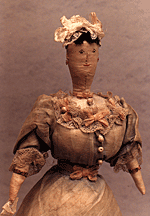 When this worthwhile enterprise became too much for Horton to
continue, she put her collection up for sale at the Rosenback Gallery in
Philadelphia, but it didn’t sell. When World War I began, she had it
hastily packed away and stored in an unused farm building in
Massachusetts. In 1922, Horton offered the collection to the Village
Improvement Society of Wenham. After discovering extensive damage done
to the collection by mice, moths, mold and breakage during storage,
Horton deeded the collection as a gift to the Society, if they would
undertake to salvage whatever was possible. When this worthwhile enterprise became too much for Horton to
continue, she put her collection up for sale at the Rosenback Gallery in
Philadelphia, but it didn’t sell. When World War I began, she had it
hastily packed away and stored in an unused farm building in
Massachusetts. In 1922, Horton offered the collection to the Village
Improvement Society of Wenham. After discovering extensive damage done
to the collection by mice, moths, mold and breakage during storage,
Horton deeded the collection as a gift to the Society, if they would
undertake to salvage whatever was possible.
Society members worked painstakingly to save
about 800 dolls from the collection, and in 1952, the dream of the
Society, to build a fireproof structure to house the collection, was
realized. Today, that same building has been expanded to include not
only the late 17-Century Claflin-Richards House, but also over 10,000
pieces of clothing, ccessories and textiles from the Victorian Era
onward, exhibited both in the house and in the museum’s galleries. In
addition to objects, the museum also has a substantial photographic
collection, including albums of tintypes and such from Wenham families.
The
Adventures of Miss Columbia
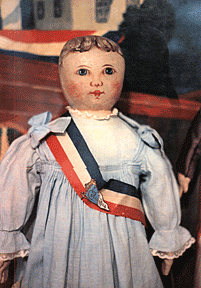 The Wenham Museum's most famous doll, "Miss Columbia,"
traveled around the world by herself for two years and nine months
beginning in 1900, raising funds for children's charities. She traveled
with a diary, collected souvenirs and returned to Horton on Christmas
Day in 1902. Today, she’s displayed with her travel diary and
souvenirs in a place of honor in the Museum. The Wenham Museum's most famous doll, "Miss Columbia,"
traveled around the world by herself for two years and nine months
beginning in 1900, raising funds for children's charities. She traveled
with a diary, collected souvenirs and returned to Horton on Christmas
Day in 1902. Today, she’s displayed with her travel diary and
souvenirs in a place of honor in the Museum.
"The doll, itself, was a commercially
produced cloth painted doll made by the Adams Sisters, of Oswego Center,
New York," said Leiberman. "Emma Adams made the dolls and her
sister, Marietta, made the clothes and was the business person. They
were making a popular doll at the time, which they exhibited at the
Columbia Exposition in 1893 in Chicago, at which the doll received a
Diploma of Merit, so they named her Columbia and sold them through all
the major retail stores and catalogs."
According to Leiberman, Horton decided to pick
one doll to represent her collection and she chose this Columbia doll.
"She ordered one from the Adams Sisters, who made extra clothes for
her," added Leiberman, "and there was a lot of hype sending
off this doll on the Adams Express Train."
Miss Columbia received a lot of publicity
throughout the world, circumnavigating the globe in the care of mostly
teachers, but not always. She went to the Philippines and spent a couple
of years there with a teacher who was sent there on a troop ship during
the U.S. occupation.
Leiberman noted that Horton’s choice of an
oil-painted cloth doll was no accident. "Women made cloth dolls in
the 19th Century," she said. "During that time,
women, like Martha Chase of Rhode Island, had an agenda. Chase headed a
group of progressives that felt that childhood needed to have nurturing
dolls and not the over-precious, breakable French dolls, with skirts
that were too short and outfits too elaborate. The emphasis was all on
show, extravagance, and expense, and the group felt that these dolls
didn’t reflect what America people and parents were about and wanted
for their children."
According to Leiberman, the group wanted dolls
that were slightly yielding, which cloth was, that could be loved and
played with and not just kept on the shelf. So a lot of cloth
doll-making women developed businesses in their homes and became quite
successful. "Mrs. Horton chose to have a cloth doll represent
America on this around-the-world journey because it represented a middle
to upper-middle class, sensible, Republican and Protestant, and probably
Congregational, child," she added. "They wanted American
values to be represented abroad."
A Doll
Ahead of Her Time
Miss Columbia was a doll ahead of her time. In an era when few
Americans could hope to travel abroad, she went around the world. At a
time when no proper young lady went anywhere alone, she set out on her
travels unchaperoned. To all appearances, she was just a simple, if
highly charismatic, doll, but she was in reality an ambassador with a
mission.
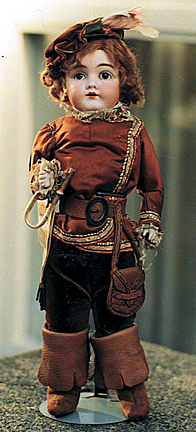 "Mrs. Horton arranged the itinerary from
her end," said Leiberman. "There was always someone throughout
the world to take care of the doll through Horton’s numerous contacts,
who were mostly teachers." "Mrs. Horton arranged the itinerary from
her end," said Leiberman. "There was always someone throughout
the world to take care of the doll through Horton’s numerous contacts,
who were mostly teachers."
Miss Columbia left Boston on the Adams Express
Train in April, 1900, traveling west and making stops in various places
before stopping in California and traveling the West Coast before
boarding a troop ship for the Philippines.
In her diary, Miss Columbia wrote on her
departure, "One little girl asked me if I were not afraid to go by
myself on the long long journey & seemed to feel very sorry for me
until I told her I was glad to go knowing I should meet with kind people
everywhere who would send me where they thought best all over the United
States perhaps & then across the ocean."
Miss Columbia journeyed across the continent
and then boarded a ship to circle the world. Her mission was to continue
Horton's charitable work for needy children, and in the process to
create a history for herself. Columbia's appearances on her trip would
be free to anyone who requested her presence. The only stipulation
attached was that at each of her stopping places a tag was to be placed
on her dress telling the circumstances of her exhibition and how much
money she had raised.
Columbia Departs
On April 12, 1900, Horton packed Miss Columbia in a telescoping
trunk and sent her on her way courtesy of the Adams Express Company
which, in conjunction with Wells Fargo Express, provided her with free
transportation across the country. Colombia may have traveled
unchaperoned, but she did not travel alone. Into her trunk went six
extra dresses, warm coat and bonnet, copies of the Boston daily and
Sunday newspaper, a red, white and blue sash and a small American flag
of silk. One of her most important accessories was a journal in which
she and her hosts were to share her adventures at each stop along the
way. Miss Columbia proved to be a faithful "journal-keeper"
though her entries were transcribed by many different hands.
 Columbia made her first appearance in Chicago,
followed by appearances in St. Louis, Kansas City, Missouri, and Omaha,
Nebraska, on her way to Denver. Her visit in Colorado was so successful
that she stayed almost a month. She’s the only doll who has ever
attended a reception on top of Pike's Peak and a dance in her honor
performed at the Southern Ute Indian Reservation. Columbia made her first appearance in Chicago,
followed by appearances in St. Louis, Kansas City, Missouri, and Omaha,
Nebraska, on her way to Denver. Her visit in Colorado was so successful
that she stayed almost a month. She’s the only doll who has ever
attended a reception on top of Pike's Peak and a dance in her honor
performed at the Southern Ute Indian Reservation.
On July 13, 1900, Columbia arrived in Los
Angeles. She’d remain in California for almost a year, appearing at
numerous fund-raising receptions and visiting hospitals and orphanages.
Everywhere she went children presented her with souvenirs of her visit–a
rosary from a Catholic childrens' home, a Chinese hymn book, a neck
chain made of seaweed from children too poor to give anything that cost
money. Miss Colombia returned from a brief trip to Alaska with a
treasure basket from an Indian boy and from Baja, California with a clay
bank and straw sombreros presented by Mexican children. Humble but
endearing gifts, these small tokens reflected the affection that greeted
the little doll wherever she went.
Finally, in July 1901, Miss Columbia secured
passage for the Philippine Islands on the U.S. Army Transport Thomas,
popularly known as the "Teachers' Transport." After the
Spanish-American War, the Philippines had been ceded to the United
States, and the U.S. government was transporting schoolteachers, as well
as soldiers, to the islands. One of these adventurous teachers, Miss
Cora E. Fay of Colorado, became Columbia's constant companion for the
next year.
Before going aboard, Columbia's face and hands
had to be thoroughly cleaned because, as recorded in her journal,
"I had been kissed by so many big folk as well as little ones. At
Denver over 600 children kissed and shook hands with me at one
reception... However my face and hands have been well washed for my
start over the sea."
Columbia accompanied Miss Fay on excursions on
Mindanao and even survived an earthquake. But by August 1902, a letter
from Mrs. Horton reminded Miss Columbia and Miss Fay of the long trip
home to Boston. Passage was found for the doll on the transport
McClellan, whose commanding officer, Captain Nye, would look out for her
more than halfway around the world. Before leaving Zamboanga, the
Collector of Customs cleared her and certified that she had complied
with the customs regulations and had not defrauded the government.
However, after inspecting her New England wardrobe, he suggested she
bring more suitable clothes on the next trip. "It doesn't snow here
very often," he wrote.
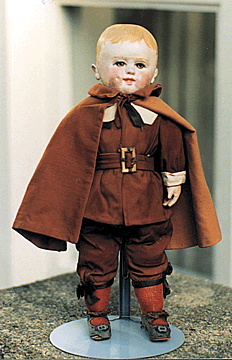 People don’t often think of Victorians as
having a sense of humor, but Miss Columbia’s journal shows that her
caretakers really got into this fantasy. Her journal gives a peek into
life at the turn of the century. No detail was too small to mention in
her journal, as can be seen in this entry: "P.S. As I am a girl
they say I ought to have a 'postscript' in my book of letters, so I add
this one. I find 'Uncle Sam', my 'escort', [note: a male doll who had
accompanied Miss Columbia on her West Coast travels] is to be left
behind, lest the natives of the new countries to which I am going will
think that he is come to take possession, which would never do at this
time so I bid him God Speed to Boston to the Care of the International
Doll Collection where I shall one day see him again." People don’t often think of Victorians as
having a sense of humor, but Miss Columbia’s journal shows that her
caretakers really got into this fantasy. Her journal gives a peek into
life at the turn of the century. No detail was too small to mention in
her journal, as can be seen in this entry: "P.S. As I am a girl
they say I ought to have a 'postscript' in my book of letters, so I add
this one. I find 'Uncle Sam', my 'escort', [note: a male doll who had
accompanied Miss Columbia on her West Coast travels] is to be left
behind, lest the natives of the new countries to which I am going will
think that he is come to take possession, which would never do at this
time so I bid him God Speed to Boston to the Care of the International
Doll Collection where I shall one day see him again."
The McClellan docked in New York, and the Adams
Express Company forwarded Miss Columbia, her souvenirs, her tags and all
of the other mementos of her trip to Boston. On Christmas Day, 1902, the
express company manager personally delivered her to Horton's townhouse.
After two years and eight months of travel her mission had been
accomplished. "She was the most famous doll in the world, and she
truly had been an ambassador of good will everywhere she went,"
said Leiberman. In Columbia’s own words: "I met with kindness
everywhere, not for my beauty but to show what good even a little plain
rag doll can do, if she tries, to make sunshine in the world."
<
Back to More Antiques to View
Next Article >
|
